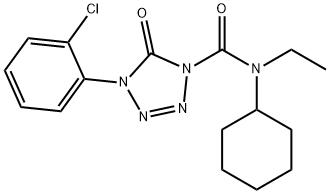Preparation
The synthetic pathway employed in the production of fentrazamide is shown in Figure 6. The reaction of 2-chlorophenyl isocyanate 8 and sodium azide in the presence of a catalytic amount of aluminum trichloride in dimethylformamide produces 1-(2-chlorophenyl)-5(4H)-tetrazolinone 9 in high yields. The tetrazolinone 9 is then mixed with N-cyclohexyl-N-ethylcarbamoyl chloride 10 in the presence of potassium carbonate and a catalytic amount of 1-dimethylaminopyridine (DMAP) in toluene to afford fentrazamide in high yields.
Following the disclosure of fentrazamide, several companies entered the herbicidal tetrazolinone chemistry race, and as a consequence many compounds of this class were prepared. The main agents included carbamoyl tetrazolinones with either a heterocycle group, a cycloalkyl group, or a heterocycle methyloxy group at the 1-position of the tetrazolinone ring, thiocarbamoyl tetrazolinones, carbamoyl tetrazolinones with tetrahydro-2H-pyran-4-yl group in the carbamoyl moiety, and hydrazine carbamoyl tetrazolinones. To date, none of these compounds have achieved commercial status.
Agricultural Uses
Fentrazamide is highly effective in the control of annual grass weeds (Echinochloa spp., C. difformis, S. juncoides) and broadleaf weeds (L. pyxidaria, M. vaginalis). It controls barnyard grass of zero- to three-leaf stage at application rates of 200– 300 g ha−1. This compound is also characterized by a long-term residual activity and shows excellent safety toward both transplanted rice and seeded paddy rice. Indeed, based on these properties, fentrazamide became the first paddy herbicide to be used as simultaneous treatment at the time of transplanting. The mixture partners of fentrazamide in one-shot paddy herbicides include sulfonylureas such as bensulfuron-methyl (Innova®) or pyrazosulfuron-ethyl (Doublestar®) and 4-HPPD inhibitors such as benzobicyclon (Smart®). In Southeast Asian countries, fentrazamide is used as a mixture with propanil (Lecspro®) to treat direct-seeded rice.

